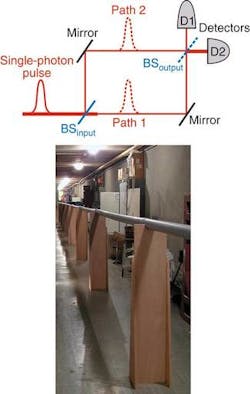
The observer’s role in quantum mechanics has been confirmed to be very weird indeed. Researchers in France have finally carried out John Wheeler’s famous “delayed choice” thought experiment, in which the intent is to determine exactly when photons decide to act like particles or waves; the experiment relies on a single-photon source developed for quantum-cryptography experiments.
The particle/wave debate in quantum mechanics has raised the specter of the observer as an inherent part of the act of measurement, and lured the philosophically minded physicist John Wheeler to ask: does a photon know it’s being watched, and when does it know? In 1978, he proposed a variation on the famed Young’s double-slit experiment, in which the decision to observe wave or particle behavior is made after the photon has passed the slits.
Several attempts have been made over the years to carry out the thought experiment, but complications have arisen largely in the search for a sufficiently stable single-photon source. Alain Aspect and Philippe Grangier at the Laboratoire Charles Fabry de l’Institut d’Optique (Paris, France) have been working on such sources since the 1980s for similar single-photon interference work. In recent years, they joined Jean-François Roch and colleagues at the Ecole Normale Supérieure de Cachan (Cachan, France) on quantum-cryptography research. The team’s single-photon source is the fluorescence provided by optically pumping a single nitrogen vacancy inside a diamond nanocrystal, which is bound in a spin-coated polymer on a dielectric mirror.
In contrast to the more common downconversion or attenuation approaches to single-photon production, the fluorescence-based source is extremely stable and leaves no doubt that just one photon is available for experimenting. The source is ideal for quantum cryptography, but clearly lends itself to more fundamental research. “This is one of the most fascinating quantum states of light that you can imagine,” Roch says. “We had the idea that it was worth using this amazingly stable source for revisiting the single-photon-interference experiments to realize Wheeler’s gedanken experiment.”
The experiment uses a Mach-Zehnder interferometer (see figure), at the end of which is an output beamsplitter and an electro-optic modulator (EOM).1 In the absence of a voltage applied to the EOM, the arrival of a photon at either detector clearly indicates the photon’s path within the interferometer, with 50% arriving from either. With an applied voltage, the paths effectively recombine and it is impossible to know which path the photon took. Accordingly, the detectors register an interference pattern.
Delayed choice
Wheeler’s experiment is realized because the decision to apply a voltage to the EOM is made when the photon is already midway through a path of some 48 m between the input and output beamsplitters. That choice is made by a quantum random-number generator that measures the shot noise on a white-light source; positive and negative values of the noise serve as a digital on/off for the EOM. In effect, the decision to look for waves or particles influences the behavior of the photon in the past, before it passed the beamsplitter. The result-quantum-mechanically unsurprising but until now unattempted-is that the experimental photon acts as a particle when the beamsplitter is not active, but as a wave when the beamsplitter is active; it doesn’t matter that the beamsplitter is activated or deactivated after the photon “chooses” its character.
“This is a beautiful example of quantum strangeness,” says Marlan Scully, a professor at both Princeton and Texas A&M University with a long history in quantum-optics experiments. “The photon cannot ‘know’ if the beamsplitter is in place or not-the choice of wave-like (beamsplitter in) or particle-like (beamsplitter out) is made well after the light pulse has left the input beamsplitter.”
Aspect is unsurprised by the result, but considers such affirmations of quantum mechanics inherently useful. “We have to realize that, at the microscopic level, our ordinary images fail at one point or another,” he says. “Pointing out exactly where they fail is always very useful and stimulating.”
REFERENCE
1. V. Jacques et. al., Science 315, 966 (2007).
D. Jason Palmer | Freelance writer
D. Jason Palmer is a freelance writer based in Florence, Italy.